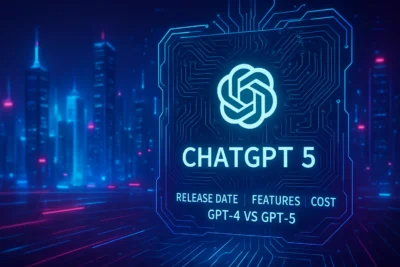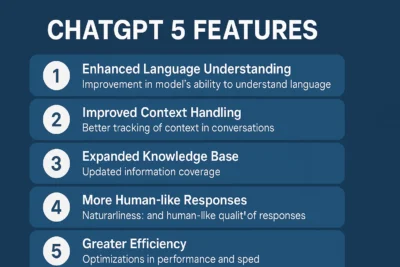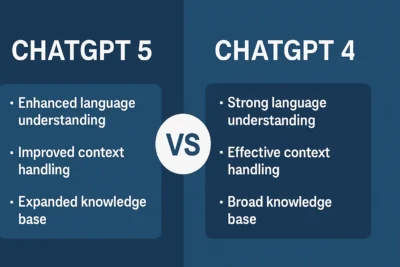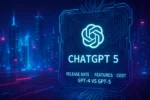
ChatGPT 5 is here—and it’s a big step forward. OpenAI’s latest model, GPT-5, brings smarter reasoning, faster responses, and more reliable answers across writing, coding, research, health, and more. It’s rolling out across ChatGPT for Free, Plus, Pro, and Team users now, with Enterprise and Edu access following shortly. Below is a comprehensive, SEO-friendly guide tailored for readers in India, Asia, and the USA.
What Is ChatGPT 5? 🌍
OpenAI describes GPT-5 as its “smartest, fastest, most useful” AI system yet, designed as a unified system that automatically decides when to use deeper reasoning for complex tasks. Instead of manually switching models, ChatGPT now routes queries to the right reasoning depth under the hood, and users can explicitly ask it to “think hard” for tougher problems. GPT-5 shows strong performance across coding, math, writing, health, and more, with notable improvements in reliability and speed.
“GPT‑5 is the new default in ChatGPT,” replacing GPT‑4o and prior models for signed‑in users.
ChatGPT 5 Release Date 📅
- OpenAI launched GPT-5 publicly on August 7, 2025, with a livestream and immediate availability for ChatGPT users.
- Rollout: Free, Plus, Pro, and Team first; Enterprise and Edu to follow the next week.
These timelines apply globally, including India, broader Asia, and the USA, with distribution via ChatGPT on web and mobile and integrations across Microsoft’s ecosystem.

Key GPT‑5 Features and AI Capabilities 🚀
- Unified system with automatic routing: Smart, efficient default + deeper reasoning when needed, guided by a real‑time router.
- Deeper reasoning on complex, multi‑variable tasks; users can select “GPT‑5 Thinking” or prompt with “think hard”.
- Faster, more reliable answers across writing, coding, math, and health; reduced major factual errors vs prior models.
- Long context: GPT‑5 supports up to 272,000 tokens input and 128,000 output in the API, improving long-document workflows.
- Developer control: New API parameters like verbosity and reasoning effort to tune length and depth.
- Safety upgrades: “Safe completions” offer high-level guidance on sensitive topics while reducing the risk of misuse.
- Multilingual improvements, with testing across major languages including Hindi and Chinese—useful for India and Asia.
- Strong coding performance: SOTA on benchmarks such as SWE‑bench Verified (74.9%) and notable tool‑use/agentic gains.
Read Also: Instagram Restyle AI: Transform Your Photos Like a Pro with Simple Text Commands 🚀📸
Availability in India, Asia, and the USA 🌐
- ChatGPT (web/mobile): GPT‑5 is the default for signed‑in users, with usage caps for the Free tier.
- Paid tiers (Plus/Pro/Team): Higher limits and access to “GPT‑5 Thinking,” with more consistent performance for heavy users.
- Enterprise/Edu: Access begins one week after initial rollout, enabling organisation-wide deployment.
- Microsoft ecosystem: Microsoft is incorporating GPT‑5 into Copilot and Azure AI services for developers and enterprises.
ChatGPT 5 Cost: What to Expect 💸
- ChatGPT Free: Access to GPT‑5 with prompt caps; automatic fallback to a mini model after limits.
- ChatGPT Plus/Pro/Team: Paid plans unlock higher usage limits and the option to select “GPT‑5 Thinking” for deeper reasoning tasks.
- API pricing: OpenAI provides GPT‑5 in Regular, Mini, and Nano variants with configurable reasoning levels; exact API rates should be checked in OpenAI’s pricing docs at launch time.
- Enterprise/Edu pricing: Through ChatGPT Enterprise/Edu or via Microsoft integrations; costs vary by organisation and region.
Note: Free vs paid primarily affects usage volume and reliability during heavier workloads, not a different underlying model for standard queries.
ChatGPT 4 vs ChatGPT 5: What’s Changed? 🧠

- Reasoning: GPT‑5 adds an integrated, automatic reasoning system that “thinks harder” on complex tasks; GPT‑4 relied more on manual model selection and prompting strategies.
- Accuracy: GPT‑5 significantly reduces major factual errors vs GPT‑4o and prior reasoning models in internal and third‑party assessments.
- Speed and reliability: Faster, more consistent answers across tasks, with better instruction following and reduced sycophancy.
- Coding: GPT‑5 achieves state‑of‑the‑art results on real‑world software tasks and tool‑calling benchmarks; improved multi‑step tool use.
- Safety/Policy: GPT‑5 emphasises “safe completions,” clearer refusals, and better transparency of limitations.
- Access: GPT‑5 becomes the default ChatGPT experience for all signed‑in users, simplifying the user journey across regions.
Who Benefits Most? Use Cases by Region 🌏
- India and Asia:
- Multilingual support and long‑context handling improve research, government RFPs, compliance summaries, and education use in local languages.
- Startups and SMBs can use GPT‑5 for coding assistants, product localisation, customer support, and marketing content across markets.
- USA:
- Enterprise-grade workflows via Microsoft Copilot and Azure AI, plus API control for agentic tasks, analytics, and software delivery. news.microsoft+1
- Professionals gain faster, more accurate writing, analysis, and coding across regulated and high‑stakes domains.
How to Access ChatGPT 5 Today ✅
- Open ChatGPT (web or mobile) and sign in; GPT‑5 is the default for signed‑in users.
- For deeper tasks, pick “GPT‑5 Thinking” in the model selector or add “think hard” to the prompt.
- Developers: Use GPT‑5 via the API in Regular, Mini, or Nano variants and tune verbosity/reasoning effort as needed.
- Businesses: Access GPT‑5 via ChatGPT Enterprise/Edu (as rollout completes) or Microsoft products like Copilot and Azure AI.
ChatGPT 5 for Developers and Teams 🧩
- GPT‑5 in API: Three models (Regular, Mini, Nano) with four reasoning levels enable fine‑grained control of speed, cost, and depth.
- Tool use/agents: Better at chaining long tool sequences, handling errors, and retrieving from long context—vital for end‑to‑end workflows.
- Prompting upgrades: New prompt migration resources and a Prompt Optimiser help teams adapt to GPT‑5 quickly.
- Early partner feedback highlights improved steerability, lower tool‑calling error rates, and superior front‑end coding.
Practical Tips to Get the Most from ChatGPT 5 🧭
- Signal intent: Say “think hard about this” for complex analysis and trade‑off evaluations.
- Control verbosity: In the API, set verbosity to low/medium/high to get concise or comprehensive outputs without rewriting prompts.
- Manage costs: Choose Mini or Nano for simpler tasks and lower reasoning levels for speed; reserve high effort for complex problems.
- Use long context wisely: Consolidate research into fewer, longer prompts where appropriate, given 272,000-token input support in API.
Final Takeaway 🌟
ChatGPT 5 isn’t just faster—it’s more adaptive, more accurate, and easier to use for everyone from students and solo creators to large enterprises across India, Asia, and the USA. With unified routing, deeper reasoning on demand, API controls for teams, and widespread availability, GPT‑5 meaningfully upgrades day‑to‑day productivity and complex workflows alike.
Frequently Asked Questions ❓
Q1: What is the ChatGPT 5 release date?
A: GPT‑5 launched on August 7, 2025, with immediate rollout to ChatGPT Free, Plus, Pro, and Team users; Enterprise and Edu follow a week later.
Q2: Is ChatGPT 5 free?
A: Yes, GPT‑5 is available to Free users with usage caps, while Plus/Pro/Team offer higher limits and access to “GPT‑5 Thinking” for deeper reasoning.
Q3: What’s the biggest difference between ChatGPT 4 vs 5?
A: GPT‑5 integrates automatic reasoning with a real‑time router, delivers fewer major factual errors, and achieves stronger performance in coding, writing, health, and multilingual tasks compared to GPT‑4‑era models.






Leave a Reply